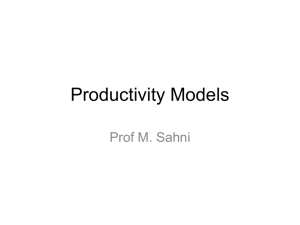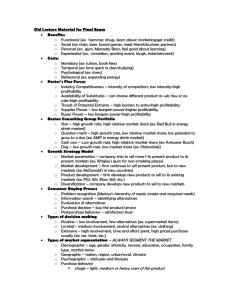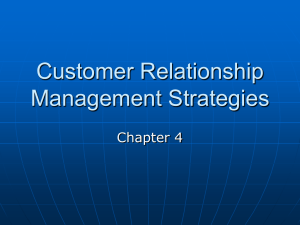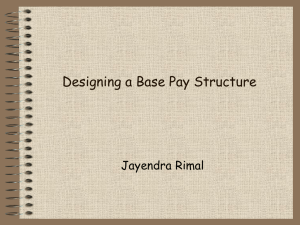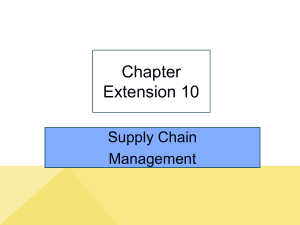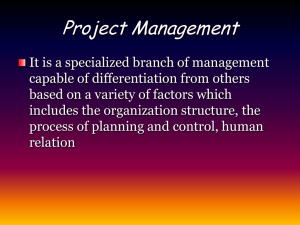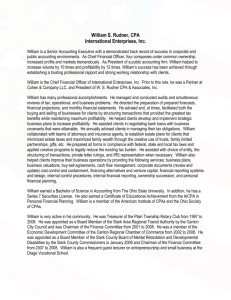determination of the impact of working capital management on
advertisement
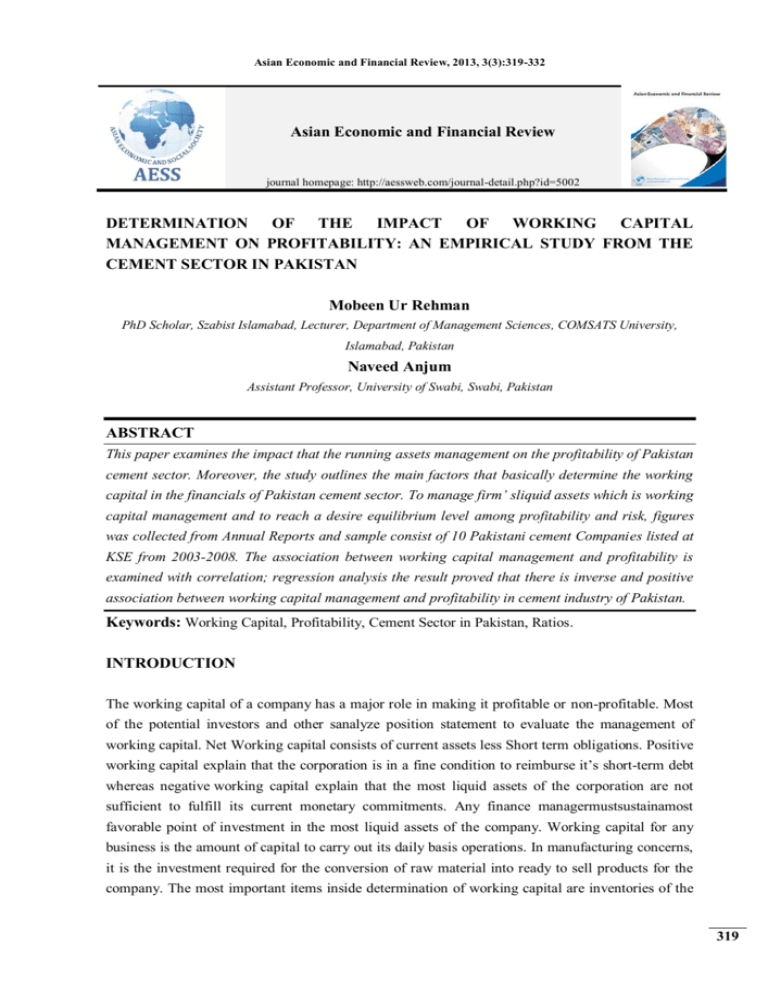
Asian Economic and Financial Review, 2013, 3(3):319-332 Asian Economic and Financial Review journal homepage: http://aessweb.com/journal-detail.php?id=5002 DETERMINATION OF THE IMPACT OF WORKING CAPITAL MANAGEMENT ON PROFITABILITY: AN EMPIRICAL STUDY FROM THE CEMENT SECTOR IN PAKISTAN Mobeen Ur Rehman PhD Scholar, Szabist Islamabad, Lecturer, Department of Management Sciences, COMSATS University, Islamabad, Pakistan Naveed Anjum Assistant Professor, University of Swabi, Swabi, Pakistan ABSTRACT This paper examines the impact that the running assets management on the profitability of Pakistan cement sector. Moreover, the study outlines the main factors that basically determine the working capital in the financials of Pakistan cement sector. To manage firm’ sliquid assets which is working capital management and to reach a desire equilibrium level among profitability and risk, figures was collected from Annual Reports and sample consist of 10 Pakistani cement Companies listed at KSE from 2003-2008. The association between working capital management and profitability is examined with correlation; regression analysis the result proved that there is inverse and positive association between working capital management and profitability in cement industry of Pakistan. Keywords: Working Capital, Profitability, Cement Sector in Pakistan, Ratios. INTRODUCTION The working capital of a company has a major role in making it profitable or non-profitable. Most of the potential investors and other sanalyze position statement to evaluate the management of working capital. Net Working capital consists of current assets less Short term obligations. Positive working capital explain that the corporation is in a fine condition to reimburse it’s short-term debt whereas negative working capital explain that the most liquid assets of the corporation are not sufficient to fulfill its current monetary commitments. Any finance managermustsustainamost favorable point of investment in the most liquid assets of the company. Working capital for any business is the amount of capital to carry out its daily basis operations. In manufacturing concerns, it is the investment required for the conversion of raw material into ready to sell products for the company. The most important items inside determination of working capital are inventories of the 319 Asian Economic and Financial Review, 2013, 3(3):319-332 corporation, its accounts receivables and payables. The management of working capital frequently considered a tool to maintaining competence of the business inside their operations. Working capital is often assessed by lenders to judge the financial short term paying back ability in difficult financial periods. Problem Statement “How the management of working capital effect profitability of Pakistani cement industry?” Objective The most important objectives of this research are as follows: Evaluate the impact of working capital management on profitability of KSE listed companies for the last 05 years. To establish the optimum level of working capital To analyze the degree of variation of ROA with respect to working capital. Hypothesis Testing Hypothesis 1 H01: There is no significant impact of Liquidity management on profitability of Pakistan cement industry H11: There is a possible positive significant impact of Liquidity management on profitability of Pakistan cement industry Hypothesis 2 H02: Inventory management does not have significant impact on profitability of Pakistan cement industry H12: Inventory management has significant impact on profitability of Pakistan cement industry Hypothesis 3 H03: Working Capital Turnover does not have significant impact on profitability of Pakistan cement industry H13: Working Capital Turnover has significant association on profitability Pakistan cement industry Model Specifications Regression analysis model of the variables is listed under mention equation. ROA= β0 + β1 (CR) + 2 β (QR) + 3 β (CTTR) + 4 β (CTSR) + 5 β (ITR) + 6 β (WTR) Rationale To judge the association between outflows of a company with its profitability, mostly the fixed capital is considered as an explanatory variable instead of the working capital which had been usually ignored. It is therefore considered to analyze the impact of working capital on profitable operations inside company. Furthermore, level of working capital is directly proportional to the 320 Asian Economic and Financial Review, 2013, 3(3):319-332 liquidity and inversely proportional to profitability therefore the risk seeker firms often decrease the level of its working capital comparative to its’ revenue. But if a company focuses on the improvement of its turnover of cash, it raises the altitude of its working capital which results in decline of revenue. Therefore the firm must prioritize its profitability and maintain optimum level of working capital. LITERATURE REVIEW AND RESEARCH MODEL The negative association between company’s accounts receivables and profitability suggests that the higher level of accounts receivables tend to increase the cash gap and therefore will reduce the working capital. Also the inverse association between the inventory turnover and ROA causes the Productivity volume decrease. (Lazaridis and Tryfonidis, 2006).In another study it was suggested that it is impossible to predict the impact on the current ratio, quick ratio, cash conversion cycle, profits and leverage when a change in sales causes a change in working capital variables. Likewise, a managerial decision that changes components of working capital will cause an unpredictable change in the liquidity, profitability and leverage ratios. Overall, the money collection phase was absolutely associated to the current plus quick ratios, to the receivables and to the inventory conversion period. There are many firms in Pakistan that have invested ample amount of cash to sustain their working capital height. Then the way in which these companies sustain their working capital height will significantly affect the profitability. An inverse association of profitability with the determinants of the running capital i.e., with the debtors’ collection time, stock change time, cash conversion cycle and the payment received time for the companies that are operating in Pakistan in the cement industry and also on KSE. Then, it’s favorable for the companies to minimize the level of inventory turnover time and also the receivables collection period to maximize the shareholder’s wealth. Also the inverse association among the creditors and productivity is found because less money-making organization tend toward increase their bill payables time. By concluding the above findings it can be suggested that the companies should manage their working capital efficiently. If the companies efficiently manage their inventories, accounts receivables and cash margins it will improve their profitability (Rehman, 2006),. In context of liquidity and working capital of the company, profitability improved lesser than the decrease in the intensity of working capital. There have been many cases where there is a positive as well as negative association of the working capital management with the productivity of the company. Many companies invest sufficiently in the working capital depending upon the size of their daily operations. In Belgian companies negative association has been observed among account receivable, accounts payable and inventory turnover and operating income. There are different approaches of different companies that can be either aggressive or conservative in investment and financing decisions. The negative relationship between the profitability, investments and financing strategies has been found using regression models. Companies having risk taking working capital strategy often gets negative return. The sum of working capital changes according to their needs of the operations of any company as does the rate of its internal cash generation. The study on paper 321 Asian Economic and Financial Review, 2013, 3(3):319-332 and printing industry has pretty high values on the different aspects of the working capital and also they have shown an optimistic relationship with productivity. In an analysis of 349 telecommunication equipment companies, negative association was observed among working capital, profitability and liquidity. The efficiency of the working capital management can be better by decreasing the payment period. It is also analyzed that the managing of inventory in the selected companies might not be efficient enough. According to the statistical tests the management of working capital has insignificant impact on the profit margins and ROA. This is because in telecommunication industry, huge equipment and towers have to be installed as the fixed assets. Also a poor management of accounts payable and accounts receivables has been noticed. There are also evidences from the private sector and manufacturing concerns in Srilanka that informal policies regarding the working capital and the size of organization influences the working capital strategies and approaches associated with it. Also, the profitability of the companies does have an impact on the methods relating to the working capital control and planning. This article attempts to place working capital policy in perspective with other policies of the small business. Contrary to common usage, working capital policy should be expressed in terms of asset liquidity, deferability of current liabilities, predictability of sales, and composition of financing (particularly debt), rather than in terms of net working capital magnitude (CA minus CL). The distinction is critical for the small business because (1) initial liquidity is generally poor (2) postpone ability of current liabilities is both an unknown and risky element (3) sales predictability when attempted is low; and (4) long-term capital is difficult to obtain (Pandey and Parera, 1997). Those interested in maintaining and extending the small business sector should increase interest in this critical area (Brain, 1996). The inefficient association of the working capital consequences in improper share of resources that will reduce the benefits that can be achieved through the current investment. If the investment in working capital is less, the firm can lose many of the profitable investment opportunities and may also get in a position to suffer short term crisis relating to its liquidity, resulting in degradation of credits of the company(Afza and Nazir, 2007). The administration of working capital is very vital in small scale firms because the maximum investment is in short term assets. Moreover, short term liabilities are also mainly externally financed. Financial data of 8,872 Spanish small and medium organizations for the period 19962002 has been analyzed. The results showed an important inverse association among productivity and the accounts receivables compilation time and ITO time and no effect of the accounts payable period. It has to be renowned that the large firms are generally more inefficient while managing working investment and but not with industry’s concentration. Profitability is inversely related with liquidity of the organization (Shin and Soenen, 1998).The under discussion research comprises on the results of annual ratings regarding the management of working capital published at CFO magazine. Also the working capital measures are not static, there have been different requirements of working capital in different sectors and therefore measuring criteria is also different. These findings are important as they provide imminent look to the performance of the working capital across time, and also shed light on working capital management across different sectors (Chiou and 322 Asian Economic and Financial Review, 2013, 3(3):319-332 Cheng, 2006) . The aggressive and conservative strategie svary from industry to industry based on the size, leverage and profitability of the firms (Filbeck and Krueger, 2003).The strong inversely negative relationship between the asset of the company and the policies relating to liabilities is found. The working capital asset policies implemented in a relative aggressive way are to be balanced by the financial policies relating to working capital in a conservative way too (Weinraub and Visscher, 1998). It is also clear that additional working capital is also required for increasing level of direct investment. As a result, these researchers visited the executives of the Japanese owned companies to determine the practices that have been practiced by them regarding the working capital. In another study it was observed that the main purpose of the Japanese shareholders was to ensure the supply of short term resources and also short term loans to facilitate the targeted output level. And this was the most prioritized objective being focused by them. Also the respondents confirmed that most of the short term funds were being provided by the Japanese investors therefore increasing the chances that the anticipation in the keiretsu system has been made. Effective management of liquidity involves the management of short term resources and short term sources to avoid the failure of fulfilling the short term obligations and due obligations of the company through its most liquid assets and to keep away from the situation in which the current assets do not exceed up to the undesired level. The association with liquidity was compared to the earnings margin of the firms by the use of current ratio and cash operating cycle through the use of correlation and regression analysis of Saudi Arabian joint stock companies. The results indicated that the short cash operating cycle has a greater relationship on productivity than the current or quick ratio. The concluded result was stable and contained significant implications for the payment of short term obligations of the companies in Saudi Arabia. Two major conclusions that were drawn are the indication of the inversely affiliation of profitability with the factors that determine the liquidity position like the current ratio and the cash gap and the second drawn conclusion was the great variation among industries relating to considerable measure of liquidity (Eljelly, 2004). Overall efficiency indices for the measurement of productivity and use of resources were calculated unlikely of calculating some common ratios of the working capital. Setting industry norms as a bench mark for achieving the targeted levels for the individual firms, this paper also calculated the time taken by any firm in achieving its targeted level of achieving the higher efficiency. The influence of an overall firm’s industry on its individual working capital management was examined. Using data on 1,181 U.S. firms over the period 1960 to 1979, a conclusion was made that a firm working capital management policies are influenced by the overall industry and is stable over time. From these studies, a conclusion was made that firm’s investment in working capital are highly influenced by the sales growth and industry practices (Hawawini et al., 1986).The two main goals of any firms are liquidity and profitability. There exist many types of costs that are related to the excesses and shortages of the levels of working capital in terms of investing and financing. If these costs are effectively managed, then the overall profitability of the firm can be increased to a maximum level. The implication of these objectives is that the decisions that maximize the profitability do not tend to increase liquidity(Moyer et al., 1995).Conversely, keeping in view the liquidity of the company is not advisable because it will negatively affect profitability. Most of the 323 Asian Economic and Financial Review, 2013, 3(3):319-332 business operations are affected by the level of working capital either positively or negatively. Purchase of raw materials results in the increase of investments or the increase in the payables or also in the payment of cash to the vendors whereas production in the company results in the increase in the finished goods or the increase in the level of work in progress inventories. Sales result in decrease in the level of work in process inventory and increases in the level of cash and receivables. The management of all the above mentioned activities is much consuming and can require additional much time if the investments in the working capital and short-term financing are even managed properly. It is therefore the reason why managers spend much of their time in management of working capital for the flat operation and also in the management of the short term debts (Scherr, 1989).Raw materials inventories are used to make schedule of the production easier, to take advantage of the changes in the prices in markets and to mitigate the risk of shortages in supplies. If the war material stock is not present, then the purchases would be on the high priced than normal rate. This will result not only in the mean high ordering costs and lower discount in the quantity, but will also cause interruptions in production due to the procurement problems of the raw material in time. So, every company prefer to purchase enough raw material so that the interruptions in the operations due to delay in the procurement process do not occur. On the basis of the level of stability relating to balances as compared to fluctuations in the volume of production and resulting sales, division of short term assets can made into fluctuating and permanent assets. The level of permanent current assets remains unchanged regardless of the fluctuationsin volume of sales or change in the production capacity. Safety stocks of inventories and cash are included in the permanent short term assets. Mostly, they are used to meet the longterm minimum needs of investment in the stage of current assets. The height of enduring current assets remains constant over a long span of time and is therefore can be compared with the company’s fixed assets because investments in permanent current assets is internal, i.e., all the investments remains within the company. The main difference between fixed current assets and permanent current assets is that fixed current assets do not change physically with time, although there are slight changes like depreciation and change in the market value whereas permanent current assets constantly change in physical terms. Due to the presence of large amount of inventories in the stock, companies stuck substantial amount of cash in them. Therefore it is suggested to manage the level of inventories effectively to decrease the inventory turnover time and to effectively manage the manufacturing operations. However, neglecting the efficient management of inventories can effect a company’s short term and long term profitability. Inventories are the least liquid categories from the entire current assets highest yield should be provided by it to justify investment (Block and Hirt, 1992). Overall, there are three motives for holding inventories in line with that of cash, first one is the transactions motive, second one is the precautionary motive and the third one is speculative motive. The first one, i.e., the transaction motive put an emphasis on the fact that inventory should be maintained in sufficient amount so that there is a smooth operation among the purchase of raw materials to the final goods production or sales to the final consumers. The second motive states that the inventory should be kept on hand to that level so that the risk of 324 Asian Economic and Financial Review, 2013, 3(3):319-332 shortage in supplies can be minimized i.e., to mitigate the risk of demand and supply factor. The third motive i.e., speculative motive refers in gaining the advantage through sufficient level to take the advantage of any price change. In the nutshell, management has to effectively manage the inventories level so that the situation of between demand and supply does not exist, to track the price changes in the market and to adjust accordingly, to have a knowledge of shortage and ordering costs of the inventory, to ensure that the inventory level shall meet the increasing production capacity of the production department and finally to have a knowledge of peak times and the variability associated with it (Stevenson, 1982).Practical management approaches are also determined by cultural practices, norms and believes. Government regulations and cultural factors also influence the working capital management policies so these factors should also be kept into consideration when designing such policies. (Williamson, 1985)Management of any company in general and working capital in particular, has become a two-edged sword. On the internal basis, working capital techniques applied to minimize the associated costs and to maximize the benefits associated with it. Externally the aim is to bridge the relation with the suppliers and customers to increase firm value. This is done by reducing the cost of inter-firm transaction and creates value of the company in a win-win condition (E. and Alvarez, 1998) When any company maintains its liquidity through borrowing, then there exists a trade-off between the profit earned from the investments in the assets that were financed from borrowing and the financing charges payable to creditors. Concluding, it can be said that the too much little level and too high level of liquidity, both have costs associated with them (Yeager and Seitz, 1989). Most of the companies would like to make sales on cash rather on the credit to avoid the excessive payables but the market pushes them backwards in terms of the competition. Also the risk is slightly higher in the sense that the trade creditors do not rely on the collateral or securities like the banks or financial institutions rather the trade is on the trust and reputation of the company (Fafchamps, 1997). Firm’s operating efficiency can be valued better through its cash flow position. There are two reasons for it. First, cash of the company is the ultimate source of value, that is, when makes investment in the resources the consumption is most likely to be delayed and the future consumption of various goods and services is made through the medium of exchange i.e., the cash that permits the company to do so. It is also a common concept that the worth of assets is determined by its ability to provide future cash flows to the company. Second, future benefits needs to be measured through some common measuring unit and cash serves as a measuring unit for this and also to make comparison of the future benefits of investment and operating opportunities (Stickney, 1996). 325 Asian Economic and Financial Review, 2013, 3(3):319-332 Theoretical Framework Independent Variables Dependent Variable Liquidity Management Inventory Management Profitability Working Capital Turnover Research Method The population for the current research work is listed cement industry of Pakistan and the convenient Sampling method has been used and the researchers have selected10 listed companies from KSE. The information has been composed for the era starting from 2003-2008.As mentioned above, the main focus regarding the data collection was through the use of secondary resources. All the secondary data of the cement companies was collected through the financial statements and also from the KSE. To calculate the sensitivity of return on asset (ROA) to change in working capital, the influence of working capital was calculated. All statistical computations have been done through Statistical package for social sciences RESULTS AND DISCUSSION The value of the co-efficient of correlation between the ratios that have been selected for measuring working capital management and return on asset are presented in Table 1. The data from correlation table highlights that current ratio return on asset has a positive effect of 0.36 at .005 percent significance. It’s obvious from the analysis that there is a weak optimistic association among the profitability and liquidity of the companies. Correlation co efficient has a 5 percent significant value. Also the value of the correlation coefficient between quick ratio and return on asset is 0.40 on a positive scale which is quite significant at 0.05 levels. So, the positive correlation between the two variables is of the lower degree. So, it is very much clear from the values of the above two ratios that the increasing level of the values of current and liquid ratios increases not only the profitability but the risk is also increased accordingly. Also the correlation between current asset and return on asset to total asset ratio has a value of positive 0.384. It simply suggests the above mentioned two variables have a positive correlation because of significant value of correlation coefficient. Then the value of coefficient of correlation between current asset to sales ratio and return on asset is 0.049 on the positive scale which is insignificant. So, a weak positive 326 Asian Economic and Financial Review, 2013, 3(3):319-332 relationship is found between the two variables. Also, lower the value of current assets to sales ratio greater will be the efficiency height of the working capital plus definitely the profitability margin will be greater. In the last, the value of co-efficient of correlation between the two variable ratios i.e., return on asset ratio and inventory turnover ratio has a positive value of 0.233, thus viewing it as having a weak positive relationship among the above mentioned variables. The value is significant at 0.5 levels but not significant at 0.05 and 0.10 level of confidence. Therefore the impact of the working capital ratios on the profitability of the corporation can either be positive or negative. The above study also confirms with the generally accepted rule that the higher value of turn over relating to the working capital i.e., inventories and receivables along with the short money change sequence does have a positive result on the overall profitability of the company. Table-1.Correlation ROA CR QR ** CTTR ** ROA Pearson Correlation 1 .362 .402 Sig. (2-tailed) .005 .002 N 59 59 59 ** CR Pearson Correlation .362 1 .957** Sig. (2-tailed) .005 .000 N 59 59 59 ** ** QR Pearson Correlation .402 .957 1 Sig. (2-tailed) .002 .000 N 59 59 59 ** ** CTTR Pearson Correlation .384 .434 .296* Sig. (2-tailed) .003 .001 .023 N 59 59 59 CTSR Pearson Correlation .049 -.140 -.113 Sig. (2-tailed) .712 .291 .394 N 59 59 59 ITR Pearson Correlation .233 .453** .421** Sig. (2-tailed) .076 .000 .001 N 59 59 59 WTR Pearson Correlation .111 .004 .015 Sig. (2-tailed) .403 .973 .912 N 59 59 59 **. Correlation is significant at the 0.01 level (2-tailed). ** .384 .003 59 .434** .001 59 .296* .023 59 1 59 -.191 .147 59 .492** .000 59 .151 .254 59 CTSR ITR WTR .049 .712 59 -.140 .291 59 -.113 .394 59 -.191 .147 59 1 .233 .076 59 .453** .000 59 .421** .001 59 .492** .000 59 -.138 .298 59 1 .111 .403 59 .004 .973 59 .015 .912 59 .151 .254 59 -.100 .451 59 -.118 .372 59 1 59 -.138 .298 59 -.100 .451 59 59 -.118 .372 59 59 Multiple Regression Analysis Linear regression has been used to analyze the impact of variables indeliberation. In table III correlation and regression techniques have been applied to conclude the impact of working capital on profitability. In this research current Ratio, quick Ratio, current assets to total assets ratio, current assets to sales ratio, working capital turnover ratio and inventory turnover ratio have been 327 Asian Economic and Financial Review, 2013, 3(3):319-332 taken as components of independent variable i.e., working capital management variable and ROA has been used as the dependent variable. Results of Regression model used in this analysis are presented in Table II exhibiting the impact of independent variable on return on asset. The multiple correlation coefficient of return on asset on current asset to total asset ratio, inventory turnover ratio, DTR, CTR and is 0.58. It indicates that the profit margin was greatly affected by current asset to total asset ratio, inventory turnover ratio, quick ratio, and current ratio. It is also obvious from the value of R2 that the independent variables current asset to total asset ratio, & inventory turnover ratio, CTR and others contributed 33.7 percent of the disparity in the profitability. In table 4 the sensitivity of return on asset due to variability in the level of working capital has been calculated using working capital leverage. Table -2.Model Summary Model R R Square Adjusted R Square Std. Error of the Estimate 1 .581a .337 .261 8.75663 a. Predictors: (Constant), WTR, CR, CTSR, CTTR, ITR, QR Table -3. Anovab Model 1 Regression Residual Total Sum of Squares Df Mean Square F Sig. 2027.217 3987.283 6014.500 6 52 58 337.870 76.679 4.406 .001a a. Predictors: (Constant), WTR, CR, CTSR, CTTR, ITR, QR b. Dependent Variable: ROA Table -4. Coefficientsa Unstandardized Coefficients Model B (Constant) -6.856 CR -16.252 QR -19.869 CTTR 26.813 CTSR .024 ITR -2.422 WTR .014 a. Dependent Variable: ROA 1 Std. Error 2.831 6.877 6.565 8.198 .020 4.905 .073 Standardized Coefficients Beta -1.112 -1.357 .523 .140 -.070 .023 t -2.421 -2.363 -3.027 3.271 1.208 -.494 .191 Sig. .019 .022 .004 .002 .233 .624 .849 328 Asian Economic and Financial Review, 2013, 3(3):319-332 CONCLUSIONS AND RECOMMENDATIONS The results indicated negative as well as positive relationship between the variables. Current asset to sales, working capital turnover ratio registered negative correlation with return on asset. The slopes of the ROA equation portray that negative and positive association of variation in the independent variables on the productivity of the company. The coefficient R2 create it understandable that 33.70 percent of the total variation in the profitability. All the three hypotheses are partially proved by the data. Although the study review it is proved that working capital management has a negative association with the productivity. It means when working capital increases, liquidity increases and profitability decreases. It is suggested that further research should be carried out in this area with some different aspects of working capital management such as payables, cash conversion cycle and receivables which are essential measurement of the working capital management. REFERENCES Afza, T. and M.Z. Nazir, 2007. Is it better to be aggressive or conservative in managing working capital. COMSATS institute of information technology Islamabad. Block, S.B. and G.A. Hirt, 1992. Foundations of financial management,. Boston, Mass: Richard D. Irwin Inc. Brain, B., 1996. Working capital policy and liquidity in the small business. theme article. Chiou, J.R. and L. Cheng, 2006. The determinants of working capital management. the journal of American academy of business, Cambridge, 10. E., R.R. and A. Alvarez, 1998. Business linc, business to business relationship that increases the economic competitiveness of firms Eljelly, A., 2004. Liquidity-profitability tradeoff, an empirical investigation in an emerging market. International Journal of Commerce & Management, 14(2): 48 61. Fafchamps, M., 1997. Trade credit in zimbabwean manufacturing. World Bank development, 25(5): 795-815. Filbeck, G. and T. Krueger, 2003. An analysis of working capital management results across industries firms? Journal of business finance & accounting, 30(3-4): 573 – 587. Hawawini, G., C. Viallet and A. Vora, 1986. Industry influence on corporation. Lazaridis, I. and D. Tryfonidis, 2006. Relationship between working capital management and profitability of listed companies in the asian stock exchange. journal of financial management and analys, 26-35. Moyer, R.C., J.R. Mcguigan and W.J. Kretlow, 1995. Contemporary financial. Pandey, I.M. and K.L.W. Parera, 1997. Determinants of effective working capital management - a discriminant analysis approach. Iima working paper no. 1349. 329 Asian Economic and Financial Review, 2013, 3(3):319-332 Research and Publication Department Indian Institute of Management Ahmedabad India. Rehman, A., 2006. Working capital management and profitability. Case of pakistani firms (unpublished dissertation). Pakistan: Comsats institute of information technology islamabad.Ricci,c. And vito,n.D. 2000. International working capital practices in the UK” European Financial Management, 6(1): 69-84. Scherr, F.C., 1989. Modern working capital management, text and cases, . Englewood Cliffs, New Jersey: Prentice-Hall International Editions. Shin, H.H. and L. Soenen, 1998. Efficiency of working capital management and corporate profitability. Financial Practice and Education, 8(2): 37-45. Stevenson, W. J. 1982. Production / operation management. Irwin: Homewood, III. Stickney, C.P., 1996. Financial reporting and statement analysis. 3rd Edn: The Dryden Press, Forth Worth. . Weinraub, H.J. and S. Visscher, 1998. Industry practice relating to aggressive conservative working capital policies. Journal of financial and strategic decisions: 11-18. Williamson, O.E., 1985. The economic institutions of capitalism, firms, markets and relational contracting. New York: Free Press. Yeager, F.C. and N.E. Seitz, 1989. Financial institution management, text and cases. Englewood Cliffs, NJ: Prentice hall. BIBLIOGRAPHY Afza, T. and M.Z. Nazir, 2007. Working capital management policies of firms, empirical evidence from pakistan. 9th South Asian Management Forum (SAMF)’ North South University, Dhaka, Bangladesh. Band, G.C., 1991. Fifty years of uk offshore oil & gas. The geographic journal, 157(2): 179-189. Banker, R.D., H.H. Chang and S.K. Majumdar, 1993. Analyzing the underlying dimensions of firm profitability. Managerial and decision Economics, 14(1): 25-76. Capon, N., J.U. Farley and S. Hoenig, 1990. Determinants of financial performance a meta-analysis. Management Sciences, 36(10): 1143-1159. Capron, L., W. Mitchell and A. Swaminathan, 2001. Asset divestiture following horizontal acquisitions, a dynamic view. Strategic Management Journal, 22(9): 817844. Cavanaugh, J.K. and J. Garen, 1997. Asset specificity, unionization and the firm's use of debt. managerial and decision economics, 18(3): 255-269. Chasteen, L.G. and R.E. Flaherty, 1997. Intermediate accounting. 6th Edn: Irwin McGraw_Hill 330 Asian Economic and Financial Review, 2013, 3(3):319-332 Deloof, M., 2003. Does working capital management affects profitability of belgian. department of management and finance, faculty of economy and business. Eljelly, A., 2004. Liquidity-profitability tradeoff, an empirical investigation in an emerging market. International Journal of Commerce & Management, 14(2): 48 - 61. Fafchamps, M., 1997. Trade credit in zimbabwean manufacturing. World Bank development, 25(5): 795-815. Filbeck, G. and T. Krueger, 2003. An analysis of working capital management results across industries firms? Journal of business finance & accounting, 30(3-4): 573 – 587. Ganesan, V., 2007. An analysis of working capital management efficiency in telecommunication equipment. the journal of financial and quantitative analysis, 3(2). Ghosh, S.K. and S.G. Maji, 2003. Working capital management efficiency, a study on the indian cement industry. The Institute of Cost and Works Accountants of India. Gondzio, J. and R.K. Berg, 2001. High performance computing for asset-liability management. Operation research, 49(6): 879-891. Griffin, J.M., 1988. A test of free cash flow hypothesis results from petroleum industry. The review of economics and statistics, 70(1): 76-82. Hawawini, G., C. Viallet and A. Vora, 1986. Industry influence on corporation. Hovakimian, A., T. Opler and S. Titman, 2001. The debt-equity choices. The journal of financial and quantitative analysis, 36(1): 1-24. Ioannis, L. and K. Lyroudi, 2000. Short-term financial management of the business in greece and in cyprus, . Business and Economics Society International Kieschnick, R., M. LaPlante and R. Moussawi, 2006. Corporate working capital management: Determinants and consequences. International Journal of Managerial Finance 3(2): 164-177. Kim, S.H., M. Rowland and S.H. Kim, 1996. Working capital practices by japanese manufacturers in the u.S. financial practice and education. Moshe, B.H., 1987. Essentials of corporate finance. Boston: Allyn and Bacon, Inc. Moyer, R.C., J.R. Mcguigan and W.J. Kretlow, 1995. Contemporary financial. Naceur, S.B. and M. Goaid, 2002. The relationship between dividend policy, financial structure, profitability and firm value. Applied financial economics, 12(2): 843-849. Padachi, K., 2006. Trends in working capital management and its impact on firms’ performance. An analysis of mauritian small manufacturing firms. International Review of Business Research Papers, 2(2): 45 -58. Pan, Y. and P.S.K. Chi, 1999. Financial performance and survival of multinational corporations in china. Strategic Management Journal, 20(4): 359-374. Pandey, I.M. and K.L.W. Parera, 1997. Determinants of effective working capital management - a discriminant analysis approach. Iima working paper no. 1349. Research and Publication Department Indian Institute of Management Ahmedabad India. 331 Asian Economic and Financial Review, 2013, 3(3):319-332 RICCI, and Vito, 2000. International working capital practices in the u k. European Financial Management, 6(1): 69-84. Robert, F.M., R.W. Jan, F.H. Susan and S.B. Mark, 1999. Accounting. 11th Edn. Roberts, P.W. and G.R. Dowling, 2002. Corporate reputation and sustained superior financial performance. Strategic Management Journal, 23(12): 1077-1093. Seshadri, S., A. Khanna, F. Harche and R. Wyle, 1999. A method for strategic assetliability management with an application to the federal home loan bank of new york. Operations Research, 47(3): 345-360. Shin, H.H. and L. Soenen, 1998. Efficiency of working capital management and corporate profitability. Financial Practice and Education, 8(2): 37-45. Stickney, C.P., 1996. Financial reporting and statement analysis. 3rd Edn.: The Dryden Press, Forth Worth. . Szymanski, D.M., S.G. Bhardwaj and P.R. Varadarajan, 1993. An analysis of market share-profitability relationship. Journal of marketing, 57(3): 1-18. Thomadakis, S.B., 1977. A value-based test of profitability and market structure. The review of economics and statistics, 59(2): 176-185. Working Capital Decisions., Sloan management review 27. 15-24. Weinraub, H.J. and S. Visscher, 1998. Industry practice relating to aggressive conservative working capital policies. Journal of financial and strategic decisions: 1118. 332

